The Specialized Turbo Tero 5.0 Is Great for Those Wanting to Do a Little Bit of Everything
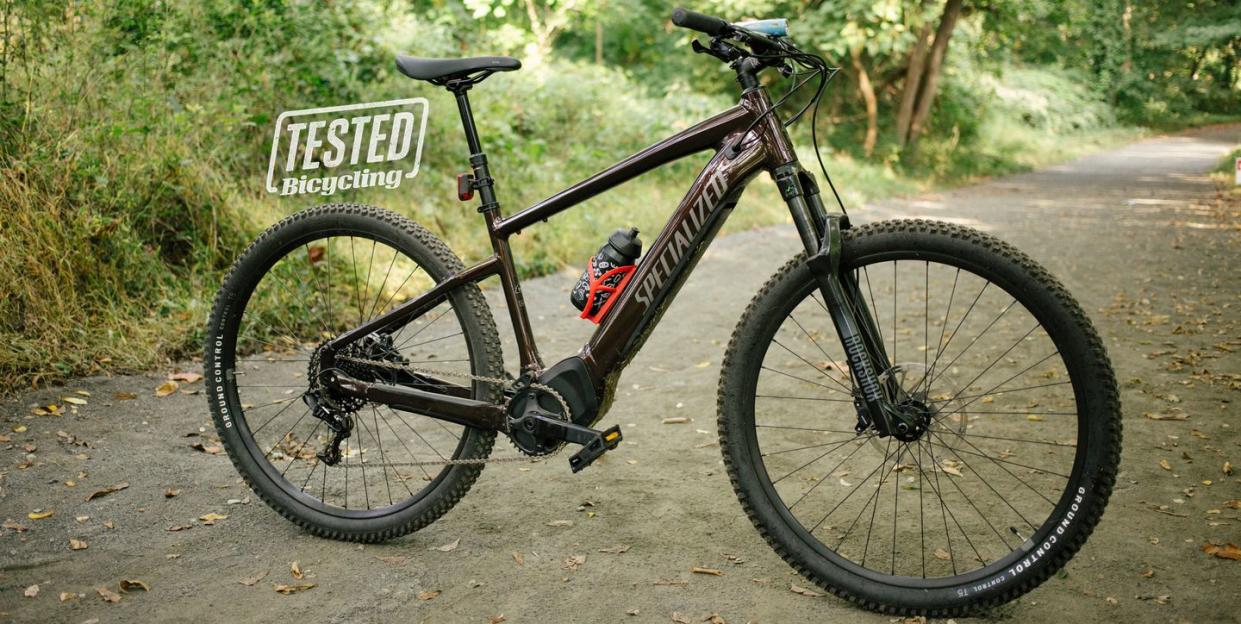
Takeaway: A capable multipurpose e-bike, the Specialized Turbo Tero 5.0 is part mountain bike, part commuter, and maybe even a short-haul bikepacker. It’s fun to ride on easy singletrack and is outfitted with plenty of mounting points for accessories. The front suspension, big tires, and upright position make it a comfortable and confident city commuter and pothole-absorber for the dirt enthusiast.
Price: $5,000
Weight: 50 lbs (size L)
Specialized Turbo Tero 5.0 Build Details
Style: Mountain/Commuter e-bike
Material: E5 Aluminum
Wheel Size: 29"
Fork: RockShox Recon Silver RL, 110mm travel, Motion-Control
Motor: Specialized 2.2, 90Nm torque, custom tuned motor, 250W nominal
Battery: Removable and lockable Specialized, alloy casing, 710Wh
Drivetrain: SRAM GX, 11-speed
Crank: Custom alloy forged crankarms, w/ Praxis 36T chainring
Pedals: Specialized platform pedal
Cassette: SRAM PG-1130, 11-speed, 11-42t
Brakes: SRAM G2 RS, 4-piston caliper, hydraulic disc, 200mm (front) & 180mm (rear) rotors
Wheels: Stout XC 29, 25mm internal width, disc-specific, Specialized alloy disc hubs, sealed cartridge bearings, 6-bolt, 32h, 15x110mm thru-axle (front), 12x148mm thru-axle (rear)
Tires: Specialized Ground Control, 2Bliss Ready, 29"x2.35"
Saddle: Rivo Sport, steel rails, 155mm
Seatpost: TranzX Dropper, 30.9mm, S: 100mm, M-XL: 120mm
Handlebar: Specialized Trail, 6061 alloy, 27mm rise, 31.8mm clamp
Stem: Stout 3D-forged alloy, 31.8mm, 6-degree rise
Other: Bell, braze-ons for fenders and racks
It was sweltering hot and humid when I first received the Turbo Tero 5.0. In other words, it’s a great opportunity to try out a new e-bike. With a press of the button on the Tero’s built-in cockpit computer, I turn it on and the bike comes to life. I immediately notice the pep of the pedal assist at my first downstroke, nice and easy to get started from a dead stop. I’m grinning rounding the first turn at the end of my block, and while I am by no means a cycling novice, I am suddenly a gleeful e-bike enthusiast.
Join Bicycling All Access for more gear reviews!
The 2022 Turbo Tero platform has two models, Tero 3.0 and Tero 5.0, priced at $3,250 and $5,000 respectably. Both models are available in four frame sizes (S, M, L, and XL), with the Tero 3.0 also available in a step-through style frame option. The 5.0 model (tested) comes in a Red Onyx/Smoke paint color while the 3.0 models are available in your choice of White Mountains/Gunmetal or Oak Green Metallic/Smoke color options.
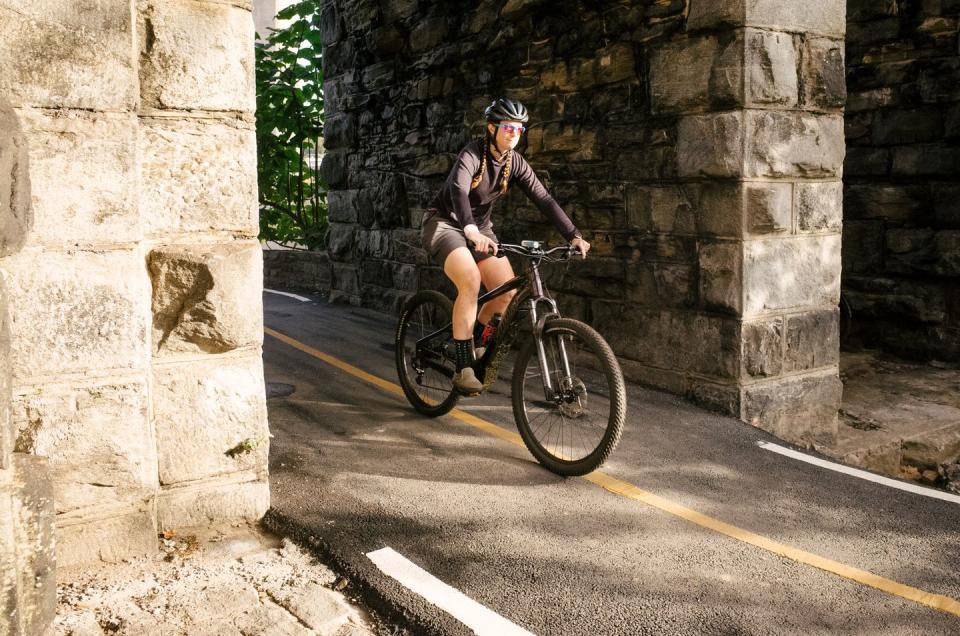
Both Turbo Tero models are versatile bikes for use around town and on less technical mountain bike trails. The Tero's front suspension, big tires, and upright position make it a comfortable and confident city commuter, but also gives you the option to take the bike on some singletrack. The Tero's rack mounts also allow you to load the bike up for bikepacking or touring.
Of the two models, the Turbo Tero 5.0 is a little more oriented to off-road riding than the 3.0. For an extra $1,750 in price, the Tero 5.0 comes equipped with upgraded suspension, drivetrain, and brakes, as well as a dropper seatpost. Most importantly, it comes with the newer Specialized Turbo 2.2 motor and a larger capacity battery. The extra 40Nm of torque, extra range of the battery, and upgraded parts provide more capability when riding on the trail.
City Commuting on the Tero
The Turbo Tero 5.0's head unit interface is customizable when paired with Specialized’s Mission Control phone app, including options to adjust power usage and the display. The Tero powered up on in Trail mode (you can change this in the app if desired), and the display features pedaling cadence (in rpm), speed, a small battery life indicator, and a clock. While labeled ‘Trail’, this mode is superb for city riding. The bike accelerates beautifully from the start at each intersection, and the responsive assist (meaning a harder downstroke by my foot results in more power from the bike) means I am joyfully cruising along in seconds. The Tero has an upright riding position, and combined with its wide handlebars, you feel confident taking the lane while in traffic.
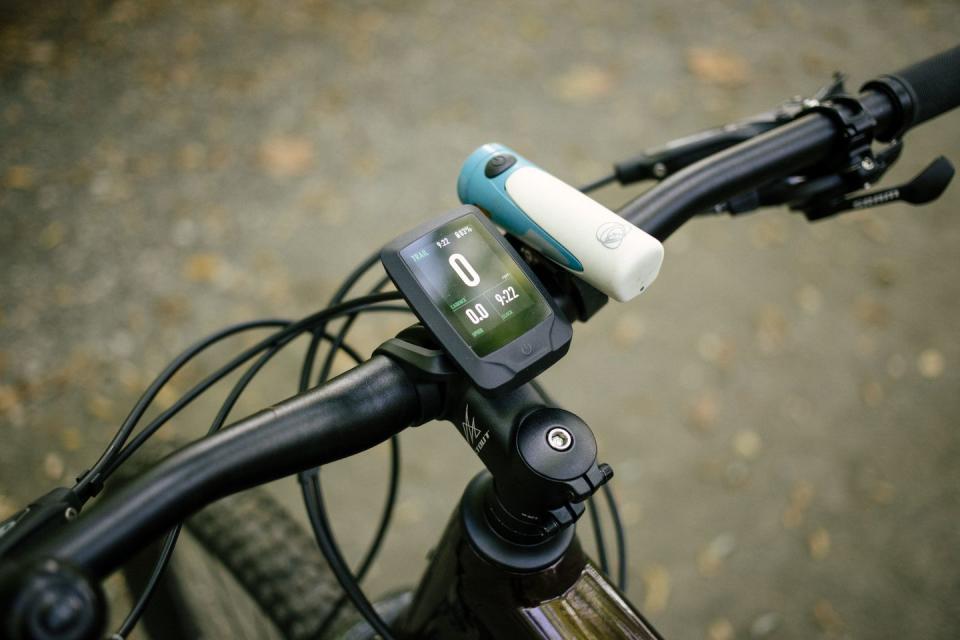
While cruising along happily on my first ride, across town in the middle of the day to deliver a hard drive to my office, I noticed the +/- buttons on the left side of the handlebars. As I approached my first incline I decided to see what the plus button does. This is when I notice that Trail mode (indicated in green) turns into the word Turbo, in yellow, along with a nicely appreciated bump in pedal assist from the motor.
After cresting the bridge, I’m back on a flat road and figure I should turn off this Turbo mode to save battery. I click down and find Eco mode (blue), which frankly feels like nothing after experiencing the full power burst of the Turbo setting. I arrive to my office not at all sweaty, which is remarkable as it is a 88 degree, and very humid, day.
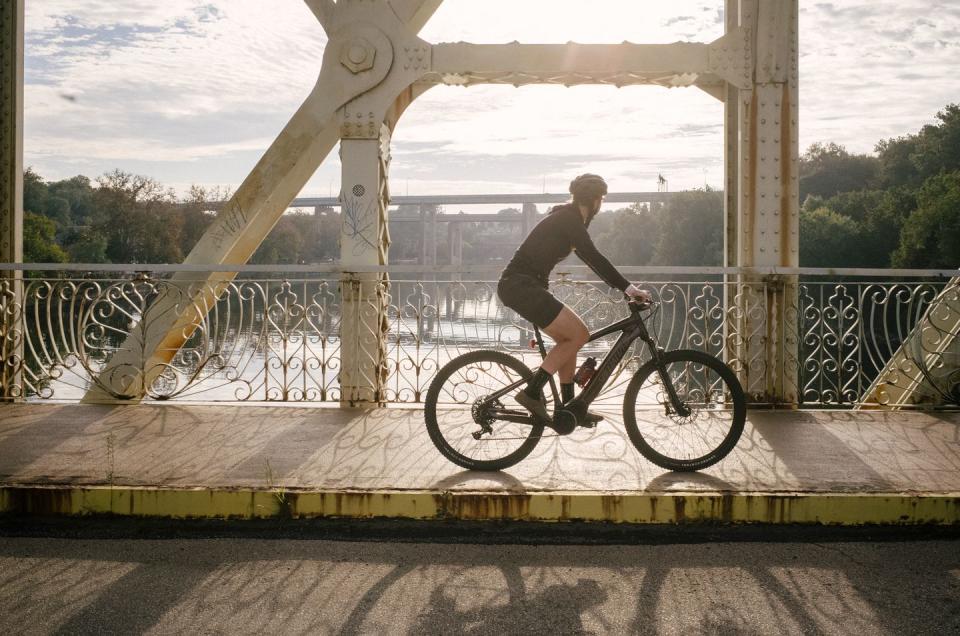
Work mission accomplished, it’s time to head back downhill to home. Since I am no longer going to be climbing, I once again tried the Eco mode, as that’s the best option for battery life. As the Eco mode has less power assist, it does feel harder to get the Tero 5.0 going from a complete stop. The bike's 36-tooth front chainring and the generous 11-42T cassette in the rear provide a sufficiently wide gear range for city commuting use.
An added bonus of the Turbo Tero 5.0 is the dropper seatpost. This feature is really nice for waiting at red lights. Just drop the seat anytime you have to come to a stop and it’s easy to put a foot down. It is much less awkward than trying to hold the bike up with your body slid forward and the post at full height.
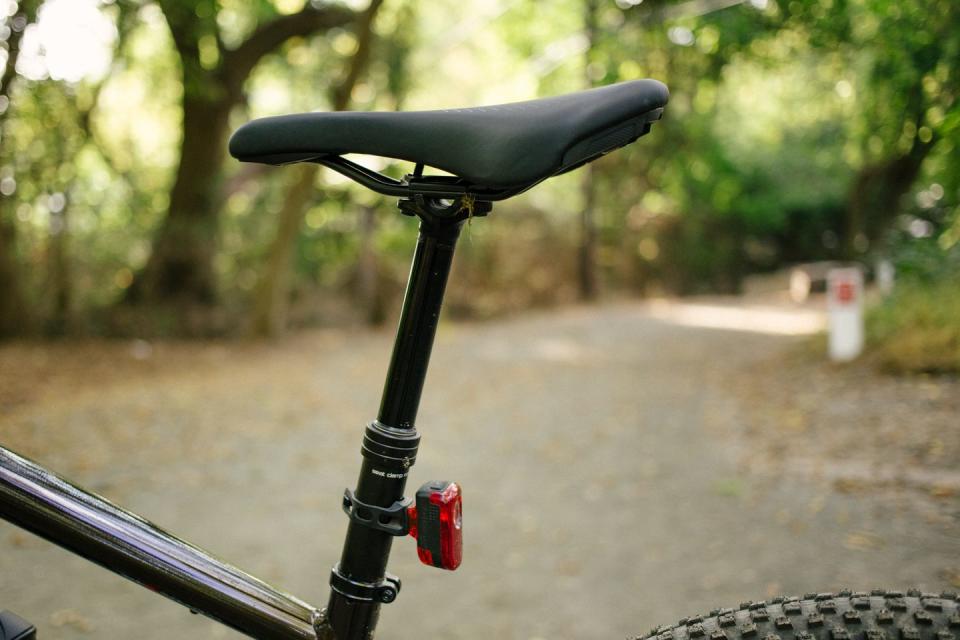
Hitting the Dirt
While the Tero 5.0 is by no means a cross-country race bike, it is certainly capable of handling multi-use dirt trails and light singletrack. I swapped out the stock flat pedals for clipless, and joined a couple friends for a ride. A great feature of e-MTBs is they make it easier to ride to the trail instead of driving there. The first trail where I rode the Tero is mostly dirt singletrack, with some roots, rocks, and a few small logs to ride over. My companions were treated to immediate giggles as I activated Trail mode and started climbing away from them.
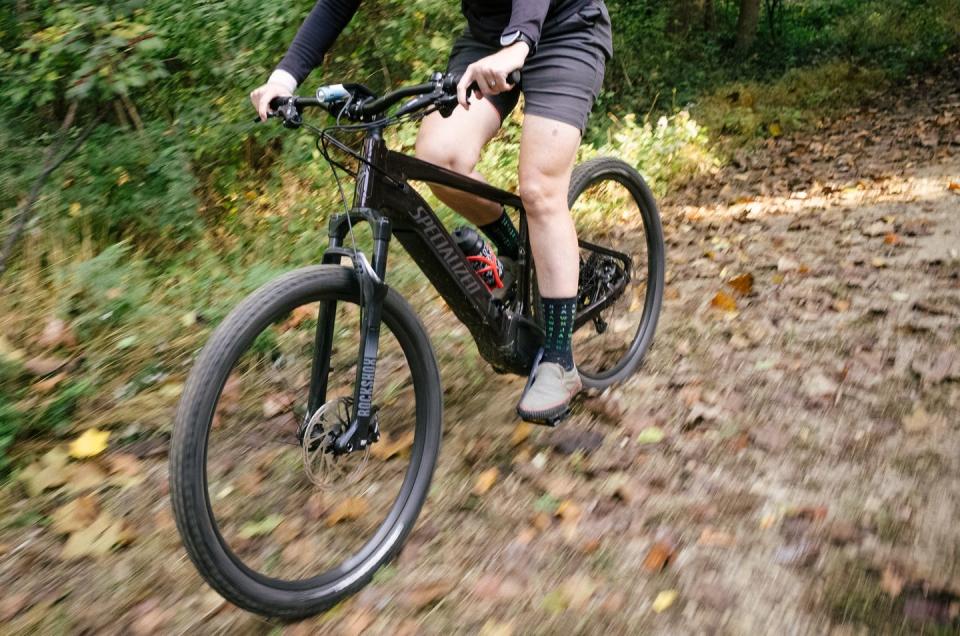
The Tero 5.0 accelerates with each downstroke of the pedal, and on the trail, this takes a little getting used to. It climbs steady, not snapping the bike through turns, but not forcing me to be out of breath. Toward the top of the climb, as I pushed harder on the pedals up the last incline, I could hear my husband working really hard to hold my wheel behind me.
That very responsive pep in Trail mode is noticeable when accelerating the Tero out of corners. One place where the assistance is less welcome is when ratcheting the pedals to get through a tight section of trail; as the bike jumped forward more than I expected when trying to finesse it. On subsequent rides, I started getting a little more acquainted with how to modulate the touch on the pedals, but it was still a bit unnatural-feeling to me as a longtime mountain biker.
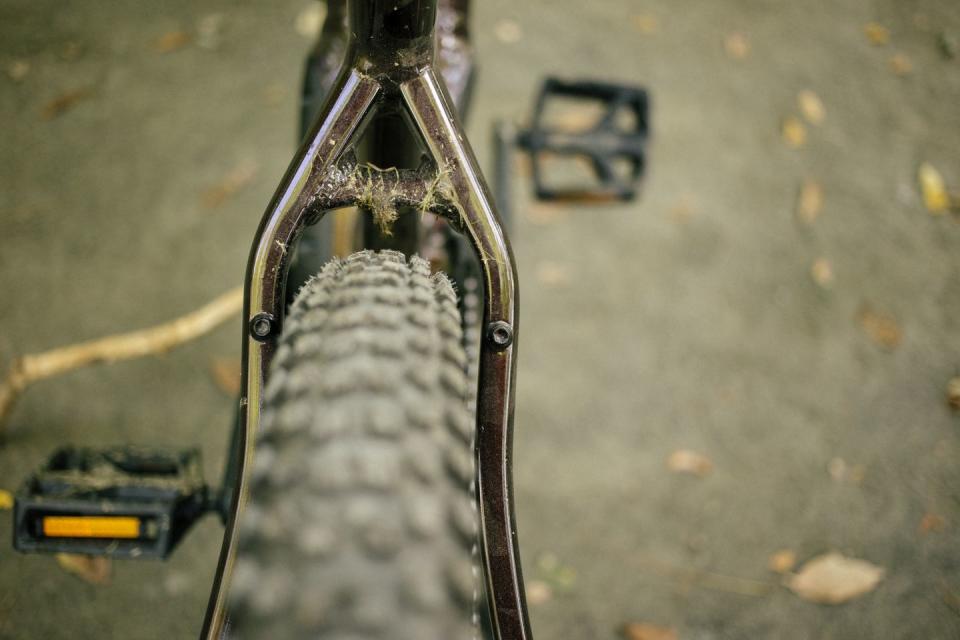
Going downhill, the Tero 5.0 remains firmly planted on the ground. At the bottom of a longer descent, a friend riding behind me noted that while I was making all the body movements of someone catching air over the small bumps in the trail, the bike doesn’t leave the ground at all. As a generally confident descender, I found the Tero holding me back from my normal downhill speed. However, if you are the type of rider who is typically more reserved on descents, the Tero will confidently get you to the bottom of the hill.
With the Tero’s low center of mass — from the downtube battery and bottom bracket motor— I found it nearly impossible to lift the rear wheel with my feet (as I am accustomed to on non-pedal assist bikes) even clipped in. I could smash the bike into, and get over, smaller logs, but when it came to larger obstacles in the trail (that typically require lifting and floating the rear wheel over on an analog bike), I needed to dismount and awkwardly carry the Tero over them. Lifting the Turbo Tero 5.0 is awkward. You cannot just pick it up by the top tube because it is too heavy, and the push assist (activated by holding down the + button) won’t help in these situations. However, if the trails you ride are well manicured, or don’t feature big step-up features or log crossings, the Tero will be very capable on them.
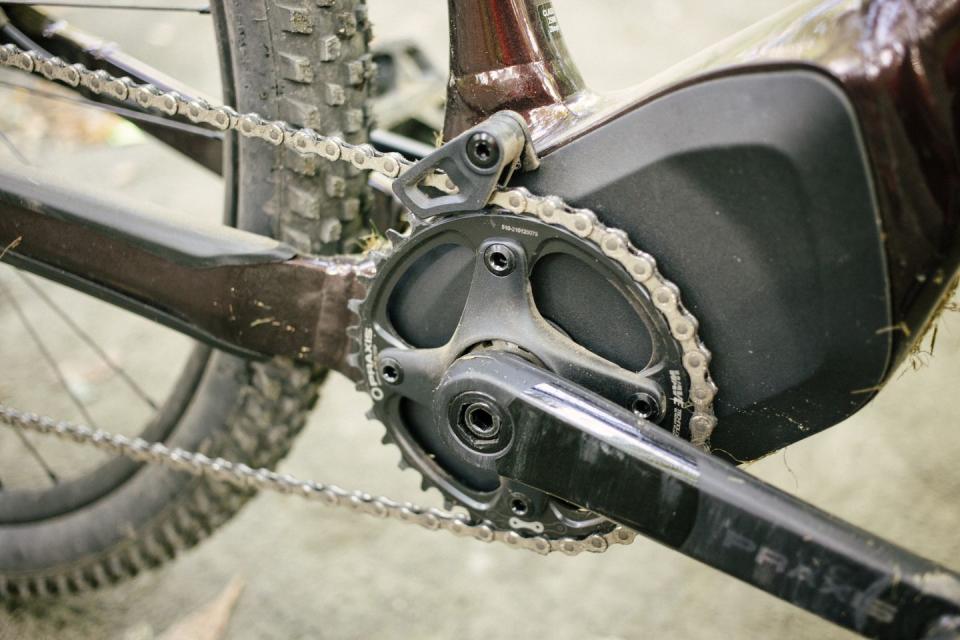
On one particular trail with a really steep climb, one that’s often hard to make it up on a non-assist mountain bike due to it being loose with a couple slippery roots, the Tero, made it right up to the top with no problems. The rear wheel remained firmly planted without the whiff of a loss of traction. But, going down the same trail with the Tero 5.0 is a different story. Even with a dropper post, the upright position made me feel a bit too on top of the bike and unstable as I pointed the bike downhill.
On one ride with the Tero I got caught in the dark. I had forgotten to bring lights, and the bike's head unit display is very bright, with no way to turn it down on the fly. While I could still make out the trail in the twilight, the brightness of the display is quite distracting. If you’re planning to ride the Tero at night, make sure you balance out the brightness of your illumination systems.
Rethinking My Commute
The Turbo Tero changed how I approached my normal commute. Now, every time I get ready to leave for work in the morning, I gravitate toward the Tero. Hauling myself up two small hills on my analog Surly Long Haul Trucker singlespeed commuter now seems like such a chore. The Tero is extremely smooth when riding on over potholes and unkept city streets. Its suspension and tires allow the Tero to simply roll off curb without a problem, though you’re not likely to have much luck hopping up one.

When riding in bike lanes, I needed to dial back my speed to go with the flow of the rest of the bikes, but I can’t overstate just how confident the Tero made me feel when mixed in with car traffic. I have been an urban commuter for over fifteen years —commuting every day, rain or shine— and all I could think about was how much easier this makes the whole endeavor. And that’s a great thing.
Who is the Tero For?
With the Tero having versatility both around town and on the trail, who is this bike for, and is it for you? The Tero 5.0 can surely fit the needs of a lot of potential riders.
As an e-MTB, if you regularly ride with someone who is a very fast mountain biker, but perhaps you are not, the Tero is a great way to enjoy trail rides together—while making them work their tails off to stay on your wheel. The Tero could also be a great addition to a high school mountain bike team’s bike fleet for coaches or parents to ride with teens as they get to be faster. Or with a towbike, the Tero would be great for getting you and your little shredder to the trails or pumptrack.

As a commuting bike, if you like having the option to dip into the trails on a longer commute, this bike would hit the mark on that. If you ride a lot of technical trails though, it likely would not be your first choice for every ride, but it could fill a need on recovery days where you still want that feeling of tires to dirt in the woods.
If you live in a city, though, this bike might have some limitations. Like with many e-bikes, the Tero might not be a bike which you will want to leave locked-up outside for prolonged periods of time. If you don’t have secure ground-level bike storage, not to mention secure bike parking at work, you should definitely give some thought to where you will store the bike when not in use. Even the option to lock the bike’s motor via the Mission Control app would not be an ample theft deterrence in a big city.

As an e-bikepacker, The Tero comes with ample braze-ons for racks and fenders, making the bike a possible option for a rider wanting to load up the camping gear and take this out for a bikepacking trip. Specialized rates the cargo limits of the Tero at 59 lbs. for the rear and 33 lbs. for the front (with a total structural limit of 300 lbs of rider and cargo). When I was visiting family in Germany a few years ago, they were telling me how wildly popular e-bike touring had become. I could see this bike filling a nice niche there, too.
On one recent ride with the Turbo Tero, 5.0 a nice older gentleman on a vintage Panasonic with panniers rolled up next to me in the bike lane and asked me about the bike. When I told him what it was, he replied that he’s on the market for a similar bike and rattled off the names of several models. If you have miles and miles of crushed limestone rail trail to explore, you might not need this much bike to do it, but you would sure have a nice time if you did. And I’m wondering if that’s what my inquisitive friend on the Panasonic was thinking about that day.
You Might Also Like